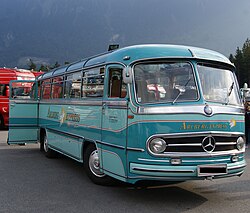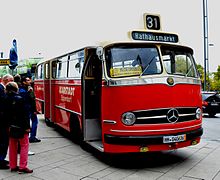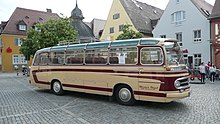Mercedes-Benz O 321
| Mercedes Benz | |
|---|---|

O 321 H coach with roof edge glazing |
|
| O 321 H. | |
| Manufacturer | Daimler Benz |
| design type | Public bus, coach |
| Production period | 12.1954-1970 |
| axes | 2 |
| engine | Diesel engines: OM 321 , (5,103 cm 3 ) or OM 322, (5,675 cm 3 ) |
| power | 81-93 kW |
| length | 9.23 m |
| width | 2.5 m |
| height | 2.9 m |
| Wheelbase | 4180 mm |
| Turning circle | 16 m |
| Seats | 26 + driver's seat |
| Standing room | 46 |
| Perm. total weight | 9300 kg |
| Previous model | O 3500 |
| successor | O 302 |
| Similar models | LAS-695 |
The Mercedes-Benz O 321 H is a bus with a rear engine of the brand Mercedes-Benz , which the Daimler-Benz AG of 6 December 1954 to 1970 in the Mercedes-Benz plant in Mannheim and in Brazil, Argentina and Greece 29,586 times produced a total of . Two thirds of the production falls on the plant in Mannheim, four units were built in Argentina, 116 in Greece and around 11,000 in Brazil. The O 321 H, which were not manufactured in Germany, were pre-produced as partial sets in Mannheim and then shipped for final assembly. It shares part of the drive technology with the L 321 .
variants
The O 321 H is a bus primarily designed as a bus and coach . O was built 321 H 1954, 1956 also in the 1.5 m extended variant O 321 HL ( H eckmotor- L HS). In addition, Daimler-Benz also delivered the O 321 H to other bodybuilders without a body and only with a front wall. The equipment varied, so the O 321 H and O 321 HL were built both as touring and city buses. There were different variants for the doors: simple wing doors that could be opened and closed manually (flap doors) at the front and rear, compressed air-operated folding doors at the front and rear or double-wide in the middle, or combinations thereof. The O 321 H had 26 seats and 46 standing places as a city bus, and 46 seats as a coach; The longer version O 321 HL had 36 seats and 48 standing places on the city bus, and 45 seats on the intercity bus.
In 1957 the first facelift was carried out, in which the windshield was extended downwards, followed in 1961 by the second facelift in which the windshield was extended upwards. At the same time, the rear window was also made in one piece. The interior was adapted to the field of application of the bus. In the case of the coach in particular, the outside of the roof was glazed and luggage nets were attached in the interior. On the outside, the coaches were usually more decorated than city buses, different colored paintwork and chrome were often used for decoration (see pictures). The buses had inner folding doors, fewer decorations on the outside and a different layout in the interior, in favor of a higher number of passengers in city traffic, fewer seats were available so that more passengers could be transported standing. A destination display at the front was also available.
technology
The O 321 H is a two-axle high-floor bus in front-link design with a rear engine . It has space for nine or eleven rows of seats in the long version (O 321 HL). The body was welded to the floor pan and was self-supporting . Luggage compartments were possible under the passenger compartment. The two axles are rigid axles and are suspended at the rear from two semi-elliptical leaf springs each with an additional stabilizer, at the front there are coil springs with additional springs and telescopic shock absorbers installed as damping elements. The front axle has single tires, the rear axle double. The 8.25–20 eHD tires are mounted on steel tapered shoulder rims of 6.5–20. A Daimler-Benz recirculating ball steering system with undivided tie rod is used for steering ; the O 321 H was also available as a right-hand drive . Braking is done with a hydraulic brake system with compressed air support (brake servo), the O 321 H has drum brakes on all wheels.
The engine is installed lengthways in the rear. A diesel engine (at Daimler-Benz: O el- M otor) of the type OM 321 was installed as standard . The OM 322 was also available from 1962. Both engines are in-line six-cylinder prechamber engines that are technically very similar. They differ primarily in a changed bore / stroke ratio and thus different displacement sizes. The OM 321 has a displacement of 5,103 cm 3 and has an output of 110 DIN PS. The OM 322 has a displacement of 5,675 cm 3 and has an output of 126 DIN PS. The driving force is an engine of single-plate type Fichtel & Sachs H 32 BH and fully synchronized, a manually-switching five-speed transmission of the type Daimler-Benz G 32 transmitted to the rear axle. Depending on the design of the bus, the transmission ratio from the gearbox to the rear wheels is 5.72: 1 for intercity buses and touring buses or 6.83: 1 for city buses.
Technical specifications
| Parameters | O 321 H (1958) | O 321 H (1961) | O 321 HL (1960) | O 321 HL (1962) |
|---|---|---|---|---|
| Dimensions and weights (mm / kg) | ||||
| wheelbase | 4180 | 4180 | 5550 | 5550 |
| Front track | 1905 | 1875 | 1875 | 1905 |
| Rear track | 1700 | 1745 | 1725 | 1745 |
| Ground clearance | 255 | 255 | 255 | 255 |
| length | 9230 | 9230 | 10600 | 10595 |
| width | 2500 | 2500 | 2500 | 2500 |
| height | 2900 | 2830 | 2830 | 2830 |
| Front overhang | 2310 | 2310 | 2310 | 2300 |
| Rear overhang | 2740 | 2740 | 2740 | 2745 |
| Turning circle diameter | 16000 | 16000 | 19600 | 19600 |
| Empty weight | Depending on the structure | Depending on the structure | Depending on the structure | Depending on the structure |
| Maximum permissible total mass | 9300 | 9300 | 10200 | 10750 |
| engine | ||||
| Engine designation | OM 321 | OM 322 | ||
| Engine type | Straight-six four-stroke - antechamber -Saug dieselmotor | |||
| Valve control | OHV valve control | |||
| Cooling system | Water cooling | |||
| Firing order | 1-5-3-6-2-4 | |||
| Dimensions | 385 kg | 400 kg | 385 kg | 410 kg |
| Compression ratio | 21: 1 | 20.3: 1 | 20.8: 1 | 22.7: 1 |
| Medium work pressure | 7.35 bar | 7.85 bar | ||
| Injection pressure | 132.39 bar | 127.5-137.3 bar | 132.39 bar | 127.5-137.3 bar |
| Bore × stroke | 95 mm × 120 mm | 97 mm × 128 mm | ||
| Displacement | 5103 cm 3 | 5675 cm 3 | ||
| rated capacity | 110 DIN-PS / 81 kW (120 hp SAE gross) at 3000 min -1 | 126 DIN-PS / 93 kW (138 hp SAE gross) at 2800 min -1 | ||
| maximum torque | 30.5 kg · m / 299 N · m at 1600 min -1 | 36 kgf · m / 353 N · m at 1600 min -1 | ||
| Further data | ||||
| Fuel consumption according to DIN 70030 | 15.2 l / 100 km | 16 l / 100 km | 15.8 l / 100 km | |
| Top speed | 95 km / h | 92.2 km / h | 95 km / h | 86.1 km / h |
| Gear ratios | 1st gear: 8.02 2nd gear: 4.785 3rd gear: 2.736 4th gear: 1.663 5th gear: 1.00 reverse gear: 8.29 |
1st gear: 8.02 2nd gear: 4.769 3rd gear: 2.754 4th gear: 1.66 5th gear: 1.00 R gear: 8.29 |
||
Literature and Sources
- Association of the Automotive Industry : Daimler-Benz AG. Mannheim: Type O 321 H . Number 870. Frankfurt am Main. May 1958
- Association of the Automotive Industry : Daimler-Benz AG. Mannheim: Type O 321 H . Number 915. Frankfurt am Main. November 1961
- Association of the Automotive Industry : Daimler-Benz AG. Mannheim plant: Type O 321 HL . Number 990. Frankfurt am Main. November 1960
- Association of the Automotive Industry : Daimler-Benz AG. Mannheim plant: Type O 321 HL . Number 1075. Frankfurt am Main. November 1962
- Daimler-Benz-Global-Media: The omnibus world champion comes in the form of the O 321 H (October 2008)
Web links
| Vehicle class | 1920s | 1930s | 1940s | ||||||||||||||||
| 6th | 7th | 8th | 9 | 0 | 1 | 2 | 3 | 4th | 5 | 6th | 7th | 8th | 9 | 0 | 1 | 2 | 3 | 4th | |
| Compact class | W 15 (type 170) | ||||||||||||||||||
| W 23 (type 130) | |||||||||||||||||||
| W 30 (type 150) | |||||||||||||||||||
| W 28 (type 170 H) | |||||||||||||||||||
| Middle class | W 02 (type Stuttgart 200) | W 136 / W 149 (types 170 V / 200 V) | |||||||||||||||||
| W 11 (type Stuttgart 260) | W 143 (type 230 n) | ||||||||||||||||||
| W 21 (type 200/230) | W 153 (type 230) | ||||||||||||||||||
| W 138 (type 260 D) | |||||||||||||||||||
| upper middle class | W 03 / W 04 / W 05 (types 300/320/350) | W 18 (type 290) | |||||||||||||||||
| W 10 / W 19 (types 350/370/380) | W 142 (type 320) | ||||||||||||||||||
| W 22 | |||||||||||||||||||
| Upper class | Type 400 & Type 630 | W 24 / W 29 / W 129 (types 500 K / 540 K / 580 K) | |||||||||||||||||
| W 08 (type Nürburg 460/460 K / 500 / type 500 N) | |||||||||||||||||||
| W 07 / W 150 (types 770/770 K) | |||||||||||||||||||
| Sports car | Model K | ||||||||||||||||||
| W 06 (type S / SS / SSK / SSKL) | W 24 / W 29 / W 129 | ||||||||||||||||||
| Off-road vehicle | W 103 (type G1) | W 31 (type G4) | |||||||||||||||||
| W 133 III (type 170 VG) / W 139 (type 170 VL) / W 152 (type G5) | |||||||||||||||||||
| Vans | L 3/4 | L 1000 Express | L 301 | ||||||||||||||||
| L 300 | |||||||||||||||||||




